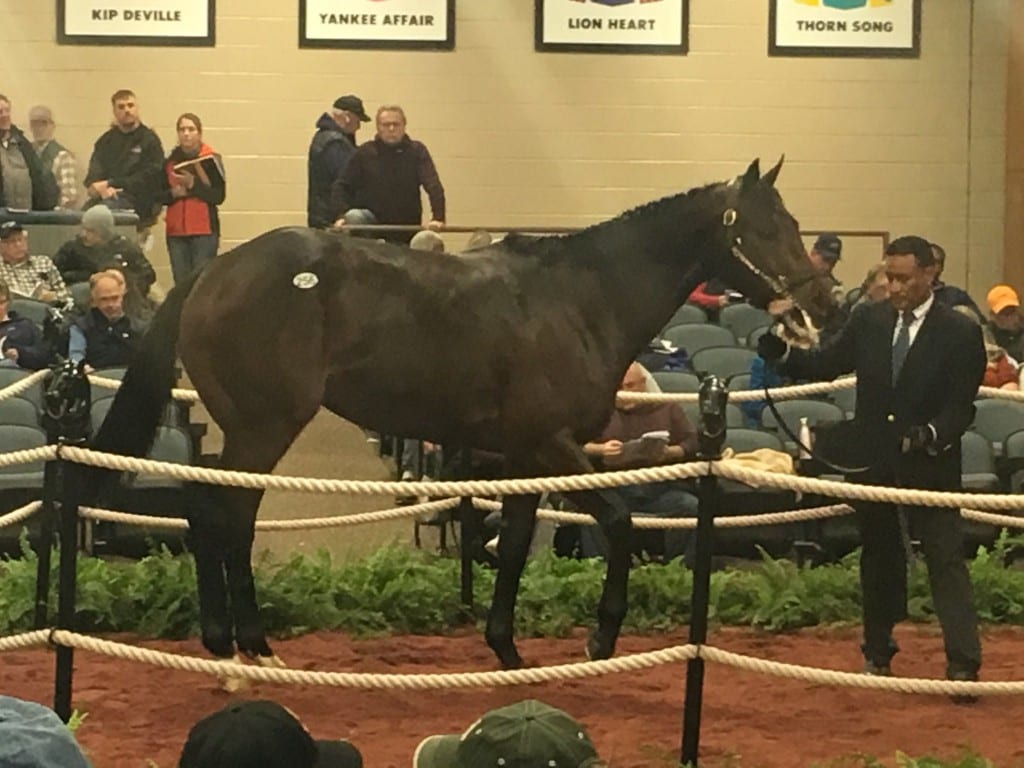Fasig-Tipton mixed: Racing age horses spark major gains

Sale topper Carradine. Photo by The Racing Biz.
by Frank Vespe
In recent years the horses of racing age segment has been something of an afterthought at the Fasig-Tipton Midlantic mixed sale.
No more.
Powered by a robust market for ready-to-go runners, yesterday’s edition of the sale returned the event’s highest gross sales — more than $2.4 million — since 2011 and highest average ($11,078) since 2013. Those numbers were up, versus the most recent mixed sale in January of this year, by 170 percent and 72 percent, respectively.
“It’s exciting to see the mixed sale do this well,” said Fasig-Tipton Midlantic sales director Paget Bennett.
Bennett oversaw a significant expansion of the horses of racing age segment for this sale. When all was said and done, 47 horses of racing age found buyers at the event, up from an average of about 14 at the last three sales. And while in prior years those horses were largely from the remainders bin, this year, driven in part by the DASL Stable dispersal necessitated by the death of owner Dr. Harry Weisleder, a number of the horses on the ground offered much to like.
“The racing age horses, which people have been asking for, it was just so rewarding to have the support,” Bennett said. “Hopefully, it’s going to be better next year now that sellers, buyers, trainers know that there’s a good outlet and people are going to be here looking to buy horses.”
The 47 horses of racing age to sell fetched a total of $767,600, good for an average of over $16,000 — the highest average of any market segment.
Their number included the sale topper, Hip 256, a three-year-old Grasshopper colt named Carradine who was one of the DASL horses here. Carradine, a New York-bred consigned by Crane Thoroughbreds, had been in the money in six of eight starts and placed in a pair of New York-bred stakes through April of this year. Linda Rice, who trained him for DASL, was the top bidder here, dropping $105,000 to keep him in her stable.
On the other end of the scale, broodmares and and weanlings were at the bottom of market segments by average sales value.
The 60 broodmares to sell fetched an average of just $8,053. The top broodmare to sell, the nine-year-old Summer Moon, brought $48,000. Also offered by Crane Thoroughbred out of the DASL Stable dispersal, she is, coincidentally, the dam of Carradine. She was sold in foal to Bodemeister. Ed Price signed the ticket for her.
The weanling market also was challenging. The 80 weanlings that sold brought a total of $747,800, an average of just $9,347. That in part reflects how far they are from running — and how much they’ll cost just to get to the next step — and in part stems from the market’s general “wait and see” attitude towards the bevy of new mid-Atlantic stallions.
“People just don’t have an interest in some of the stallions yet and are unsure and don’t want to take a chance,” Bennett said. “The ones they’re passing by today, when they get their first runners and are doing well, we’ll see a whole different change. People are hesitant. They want the proven product.”
All eight of the sires with three or more weanlings on offer are based in the mid-Atlantic. All eight sires had weanling sales averages under $9,000, and 35 of their 36 weanlings sold here fetched $10,000 or less. The lone exception was Hip 156, a Super Ninety Nine colt consigned by Bill Reightler that fetched a top bid of $24,000 from Mary Sue Stable.
All of that also was symbolic of the longstanding grievance of sellers at sales around the country: plenty of money for good horses and not much at all for the rest. The top quartile of horses averaged over $32,000 here and accounted for 72 percent of the sale’s gross; the bottom quartile averaged less than $1,500 and comprised only 3.3 percent of gross.
“Horses that people want, they pay for,” Bennett said.
Yesterday marked a return to the sale’s traditional December date after two such events — earlier this year and in 2016 — having taken place in late January. While the January move was made to shake up a sale that in December 2014 had a buyback rate of 33 percent, it seems clear that the switch back to December was the right move.
Yesterday’s buyback rate was just 21 percent, and the gross (156 percent) and average (27 percent) were both well above that of the most recent December sale.
“Everybody clearly wanted to go back to December,” Bennett explained. “A lot of our consignors are still involved with foaling mares, so some of them in January have mares under lights, so they didn’t have the stalls available to prep horses for the sale so that became problematic, and all their staff was occupied. We’re here for our consignors, (and) clearly we know now that December works.”
So, given the progress made yesterday, it’s safe to assume that the next mixed sale in Timonium will take place in December a year from now.
“Moving the sale to December was a good move, proved to be very successful,” Bennett said. “It’s something we can build on next year.”







